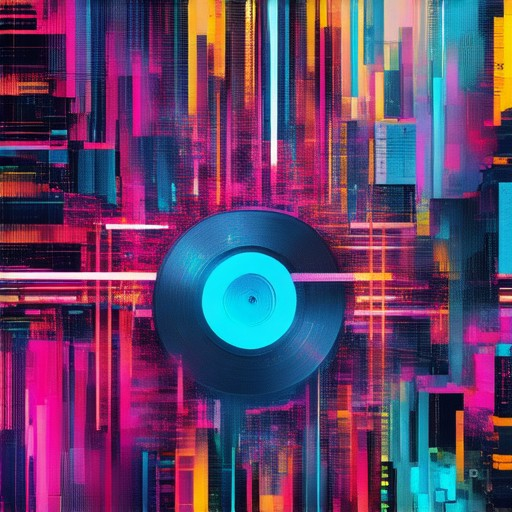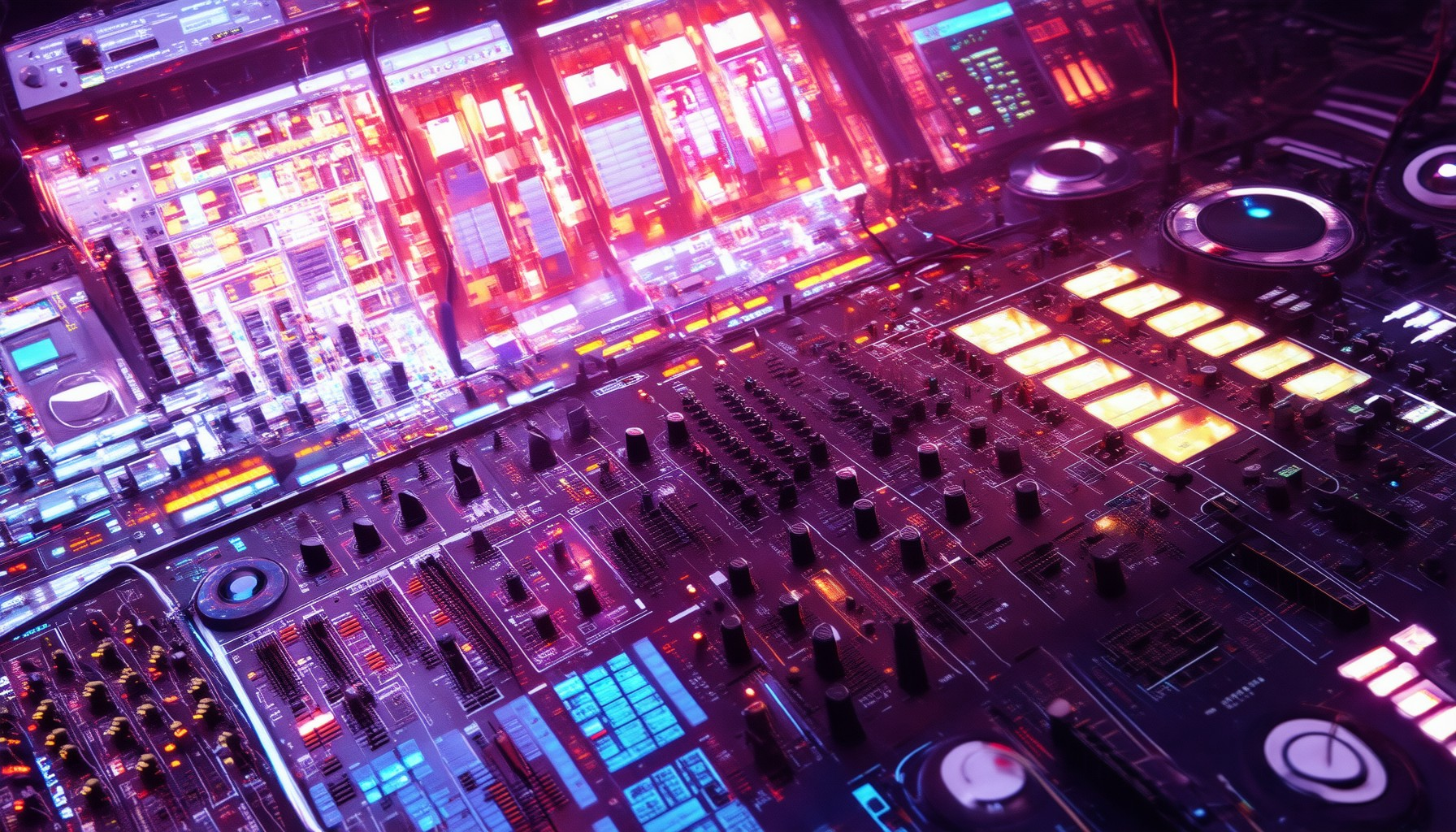Hip-hop culture has long been a beacon of innovation, reshaping music, art, and societal norms. At its core, hip-hop production innovation has driven the genre’s evolution, transforming raw beats into dynamic soundscapes that resonate globally. The fusion of technology and creativity has redefined what it means to produce music, blending traditional techniques with cutting-edge tools to push boundaries and inspire new generations. From the birth of break beats to modern studio wizardry, hip-hop production innovation continues to forge new paths, challenging expectations and redefining the genre’s identity. This exploration delves into the historical milestones, technological advancements, and visionary minds behind the sounds that have shaped hip-hop’s cultural landscape.
Key Takeaways
– Pioneering Producers: Iconic figures like Dr. Dre, Kanye West, and J Dilla have revolutionized hip-hop production with groundbreaking techniques and innovative sounds. Their work continues to shape the genre’s evolution.
– Essential Tools: Producers rely on Logic Pro X, Ableton Live, FL Studio, Cubase, and Ableton Push to create, manipulate, and perform beats, leveraging cutting-edge software and hardware for studio excellence.
– Top Sellers: Eminem reigns as the best-selling hip-hop artist of all time, with over 224 million equivalent album sales, while Jay-Z, Dr. Dre, and Kanye West closely trail behind in terms of global impact and influence.

Production Techniques Used in Hip-Hop
Hip-hop production involves a blend of rhythmic beats, vocal performances, and creative manipulation of audio elements. Here are the key techniques used:
Sampling
Producers frequently sample snippets from various genres, including funk, soul, jazz, and rock. These samples are often looped, pitched, and layered to create unique rhythms and textures. Popular samples include James Brown’s “Funky Drummer” and Public Enemy’s “Fear of a Black Planet.”
Beatmaking
Beats are constructed using drum machines, synthesizers, and digital audio workstations (DAWs). Tools like Akai MPCs and Ableton Live are commonly used to program rhythms, basslines, and melodies. Many producers also use breakbeats, which are short, looping rhythm patterns popularized by early hip-hop tracks.
Layering and Mixing
Tracks are built by layering vocals, instrumental parts, and effects. Mixers use EQ, compression, and reverb to balance and enhance each element. This process allows for a rich, full-bodied sound while maintaining clarity.
Live Performance Techniques
DJing and turntable scratching are integral to live performances. Techniques like scratch drops, needle drops, and transitions showcase the DJ’s skill and contribute to the energetic vibe of a show.
Use of Effects
Producers incorporate effects like echo, delay, and bit-crushing to create atmospheric sounds. These effects are often applied to vocals and instrumentation to add depth and texture to the track.
Collaboration and Genre Blending
Hip-hop producers draw inspiration from diverse genres, incorporating elements of jazz, funk, reggae, and electronic music. Collaborations with artists from different backgrounds lead to innovative sounds and styles.
Choreographing Rhythms
The relationship between lyrics and rhythm is crucial. Producers carefully craft the timing and delivery of rhymes to match the beat, ensuring the music and words complement each other.
Mastering
Final touches are applied during mastering, ensuring the track is sonically polished and ready for release. This stage fine-tunes dynamics, stereo imaging, and overall listening experience.
These techniques collectively allow hip-hop producers to create dynamic, impactful tracks that resonate globally.
Technological Advancements in Hip-Hop
Hip-hop has always been at the forefront of technological innovation, blending audio engineering, music production, and artistic expression. Here are some key areas where the genre has pushed boundaries:
1. Turntables
The turntable, invented in 1877, became a cornerstone of hip-hop DJing. Early DJs like Afrika Bambaataa and DJ Kool Herc used turntables to create loops and scratch records, developing the foundation of what would become breakdancing and beatmatching.
2. Synthesizers
Synthesizers revolutionized music production in the 1970s, allowing artists to create lush, layered sounds. Artists like Kraftwerk and Herbie Hancock incorporated synths into their music, influencing hip-hop producers to use these tools for basslines, melodies, and textures.
3. Drum Machines
Drum machines became essential in hip-hop production, enabling precise rhythmic patterns. The Akai MPC series, introduced in the 1980s, set a standard for beat-making, allowing producers to create complex rhythms and samples.
4. Samplers
The sampler changed the game by letting producers reuse audio snippets. The Roland TR-808 and SP-12 were groundbreaking, enabling the creation of iconic hip-hop beats. Producers like Pete Rock and DJ Premier used samplers to build tracks from scratch.
5. Digital Audio Workstations (DAWs)
Modern hip-hop producers rely on DAWs like Ableton Live, Logic Pro X, and FL Studio. These tools allow for advanced editing, mixing, and production techniques, enabling intricate layering of sounds and beats.
6. Beatmaking Software
Software like Reason, Maschine, and Logic Pro have democratized music production. Artists can now create beats on laptops, with tools like sample libraries and virtual instruments making the process more accessible and creative.
7. Streaming and Production Platforms
Streaming platforms like Spotify and Apple Music have reshaped how hip-hop is consumed. Artists use these platforms to promote their music and engage with fans, while producers leverage streaming data to understand listener preferences and tailor content.
8. Visuals and VR
Recent advancements in VR and interactive visuals are transforming live performances. Artists like Björk and Daft Punk have used immersive visuals, setting a new standard for how hip-hop acts can engage audiences.
These technologies continue to evolve, pushing the boundaries of hip-hop production and consumption. From the analog tools of the past to the digital innovations of today, hip-hop remains a driving force in music innovation.
For more insights into hip-hop culture and technology, visit Abstract Hip Hop .

Kool Herc’s Innovation in Hip-Hop
Kool Herc, whose real name is Herbie Hancock, is widely regarded as one of the foundational figures in the development of hip-hop culture. His most significant contribution came from his innovative approach to DJing and his promotion of the MC (Master of Ceremonies), which revolutionized the role of DJs in hip-hop events.
One of Kool Herc’s key innovations was the emphasis on the DJ as a central figure in hip-hop parties. Unlike previous iterations of block parties, Herc elevated the DJ’s status to becoming the main attraction. He utilized the turntable to create seamless transitions, scratch records, and mix tracks in a way that had never been seen before. This technique allowed for longer sets and more dynamic performances, making the DJ a star rather than just a backdrop musician.
Another major innovation was the introduction of the MC. Kool Herc recruited emcees like Afrika Bambaataa and DJ Cool Herc (his brother) to keep the crowd engaged between records. The MCs would freestyle, tell jokes, and hype up the audience, creating a more interactive and entertaining experience. This role of the MC became a staple in hip-hop culture and has evolved into the prominent position it holds today.
These innovations by Kool Herc not only changed the landscape of hip-hop but also set the stage for the creation of block parties, the rise of the DJ as a cultural icon, and the evolution of the MC. His influence can be seen in nearly every aspect of modern hip-hop, from beatmaking to lyrical content, and has inspired countless artists and generations.
- The elevation of the DJ as a primary performer
- The creation of the MC role
- Techniques in turntable manipulation
- The organization of large-scale block parties
This foundational work by Kool Herc and others like him laid the groundwork for the development of hip-hop as a global cultural phenomenon. Their innovations continue to shape the music, art, and culture of hip-hop around the world.

Who is the biggest producer in hip-hop?
The title of the biggest producer in hip-hop is often debated, but several names consistently stand out for their groundbreaking work. Among them, Dr. Dre is widely regarded as a legend in the genre, shaping its sound with iconic productions like those featured in his solo albums and collaborations.
Other prominent names include:
- J Dilla , known for his intricate beatmaking and contributions to Detroit’s hip-hop scene.
- Kanye West , whose innovative approaches to sampling and production have redefined modern hip-hop.
- Pharrell Williams , a versatile producer behind hits like “Clapping Song” and “Numbertime.”
- Swizz Beatz , famous for his high-energy beats and work with major artists.
- Timbaland , known for his experimental styles and contributions to early 2000s hip-hop.
Each of these producers has left an indelible mark on the genre, with their unique styles influencing countless tracks. For more details on their contributions and the evolution of hip-hop production, visit our articles on The Evolution of Hip-Hop Production and Top Producers in Hip-Hop .
What Program Do Most Hip-Hop Producers Use?
- Logic Pro X : Known for its robust editing and mixing tools, Logic Pro X is a favorite among hip-hop producers for its versatility and advanced features.
- Ableton Live : Renowned for its live performance capabilities, Ableton Live is widely used for creating and manipulating loops, which are integral to hip-hop production.
- FL Studio : A popular choice due to its flexibility and affordability, FL Studio offers extensive virtual instrument support and effects, making it ideal for beat-making and track creation.
- Cubase : Often used in professional settings, Cubase provides high-quality recording and mixing tools, appealing to producers seeking advanced features and precision.
- Ableton Push : A hardware controller compatible with Ableton Live, Push is a staple in many producers’ setups, offering hands-on control for live performances and studio sessions.

Who is the #1 Selling Hip-Hop Artist of All Time?
Eminem is widely regarded as the best-selling rapper of all time, with over 224 million equivalent album sales (EAS) as of May 2025.
- Eminem: With over 224 million EAS, Eminem leads the pack in global record sales. His extensive discography includes groundbreaking albums like “The Marshall Mathers,” “The Eminem Show,” and “Revival,” among others.
- Jay-Z: Often cited as a close rival, Jay-Z has sold over 175 million EAS. His work with Roc-A-Fella Records and later Def Jam helped cement his status as one of the most influential rappers.
- Dr. Dre: Known for his vast influence on West Coast hip-hop and his role in launching successful labels like Aftermath Entertainment, Dr. Dre has sold over 150 million EAS. Hits like “The Chronic” and “Detox” contribute to his massive sales numbers.
- Kanye West: A polarizing yet highly influential figure, Kanye has sold over 140 million EAS. His “Yeezy” brand and albums like “Yeezus” and “Donda” have solidified his place among the top sellers.
While Eminem holds the crown based on EAS, other artists like Jay-Z, Dr. Dre, and Kanye West often compete closely depending on the metric used. AbstractHipHop.com explores these debates in-depth, examining the complexities of music sales across different eras and platforms.
Learn more about Eminem’s career and discography on AbstractHipHop.com.





0 Comments